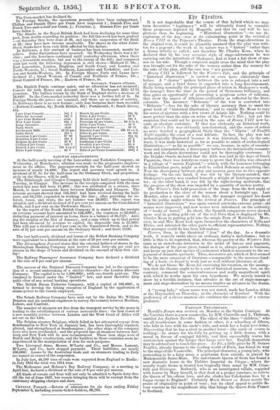tt4t 14tatrts.
It is not improbable that the course of that hybrid which we may term decorative " legitimacy" will be ultimately found to resemble those progresses depicted by Hogarth, and that its end will be less glorious than its beginning. " Historical illustration "—to use the euphuism of the day—was at its culminating point in the revival of Henry TIII at the Princess's Theatre. From the stage-directions in the original text, it could be plausibly assumed that the play was writ- ten for a pageant ; the work in its nature was a " history" rather than a drama strictly so called ; and therefore Mr. Charles Kean, when he declared that by his very accurate style of stage-adornment he was carrying out the intentions of Shakspore, had at least a fair show of rea- son on his side. Though a suspicion might cross the mind that the play was brought out for the sake of the scenery rather than the scenery for the sake of the play, still the ease was " not proven." Henry VIII is followed by the Winter's Tale, and the principle of " historical illustration " is carried on even more elaborately than before. A " chorus " spoken between the acts is enlarged into a sort of masque, and a brief dance is expanded into a long divertissement. Sicily being nominally the principal place of action in Shakspere's work, the manager fixes the time in the period of Syracusan brilliancy, and thus gains an opportunity of presenting a gorgeous series of tableaux, that show the aspect of Athenian civilization as reflected by the Doric colonists. The incorrect " Bohemia " of the text is converted into " Bithynia "—less for the sake of literary accuracy than to assist the great work of "historical illustration," and to enable Mr. Kean to vary his series of pictures with a few views of Asiatic life. Nothing could be more perfect than the raise en scene of the Winter's Tale; but yet the suspicion that could not be proved in the case of Henry VIII now be- came an absolute certainty. If that was obviously an historical work, the Winter's Tale was obviously non-historical, and the scene of action no more denoted a geographical Sicily than the " Illyria " of Twelfth, Night signifies the coast of a real Adriatic. In fact, the play was not archaeologically illustrated because it was historical, but, on the con- trary, it was made historical as far as possible to admit of arehmologieal illustration ;—" as far as possible" we say, because, in spite of emenda- tions and interpolations, a discrepancy between the intrinsically romantic work and its classic decorations could not be thoroughly overcome. If the Delphic Oracle declared that the fable was laid in the days of Greek Paganism, there was Autolycus ready to prove that Perdita was educated in a village of " merrie England,"—which, with the looseness belonging to Elizabethan poets, might as well be called Bohemia as anything else. Now the discrepancy between play and scenery gave rise to two opposite feelings. On the one hand, it was felt by the literary-minded, that , Shakspere's poetry was crushed beneath a weight of heterogeneous mat- ter ; on the other hand, it was felt by the sight-loving multitude, that the progress of the show was impeded by a quantity of useless poetry. The Winter's Tale held possession of the stage from the first night of its production to the close of the season about a fortnight ago. Last Monday, after a repose of nine days, the manager reopened his doors that the public might witness the revival of Pizarro. The principle of " historical illustration " was again carried out to the extreme point ; old scenes were improved, and new scenes were introduced on the authority of " books of travel." In short, the Spanish conquerors never showed more zeal in getting gold out of the real Peru than is displayed by Mr. Charles Kean in putting gold into the mimic rein of Kotzebue. Moro- over, he and Mrs. Kean took upon themselves the characters of Rolla and Elvira, and intrusted the other parts to efficient representatives. Nothing that manager could do has been left undone. Pizarro, then, is the theatrical " lion" of the day. As a dramatic work, it scarcely ranks above an ordinary Astley's melodrama; but so little is this to be regretted, that, whereas the poetry of the Winter's Tale came as an unwelcome intrusion in the midst of dances and pageants, the dialogue of the prose piece, tumid as it is, always points to business, and keeps up just that species of excitement which is necessary to the en- joyment of dramatic spectacle. Thus, decorative art, which at first seemed to be the mere ornament of literature—comparable to the morocco-bind- ing of a book—is found to work just as well without literature at all. We do not blame Mr. Kean for exercising his vocation, on the assump- tion that the theatre ought to be a sort of historical museum, but, ion the contrary, commend the conscientiousness and really magnificent spirit with which he works upon his own hypothesis. We merely intend to show by a forcible instance, that advance in the art of stage-manage- ment and stage-decoration by no means implies as advance in the drama.


































 Previous page
Previous page